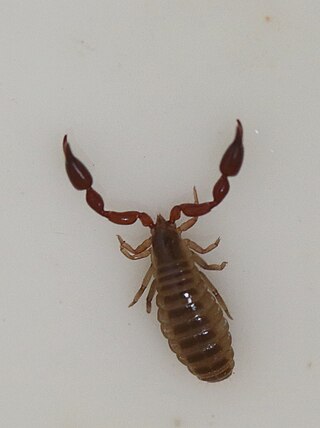
Pseudoscorpions, also known as false scorpions or book scorpions, are small, scorpion-like arachnids belonging to the order Pseudoscorpiones, also known as Pseudoscorpionida or Chelonethida.
Atemnidae is a family of pseudoscorpions, first described by Kyukichi Kishida in 1929.

Oratemnus is a genus of pseudoscorpions in the family Atemnidae.
Illinichernes distinctus is a species of pseudoscorpion in the family Chernetidae.
Tyrannochthonius cavicola is a species of pseudoscorpion in the Chthoniidae family. It is endemic to Australia. It was described in 1967 by Austrian arachnologist Max Beier.
Tyrannochthonius cavernicola is a species of pseudoscorpion in the Chthoniidae family. It is endemic to Australia. It was described in 1976 by Austrian arachnologist Max Beier.
Sathrochthonius insulanus is a species of pseudoscorpion in the Chthoniidae family. It is endemic to Australia. It was described in 1976 by Austrian arachnologist Max Beier.
Sathrochthonius crassidens is a species of pseudoscorpion in the Chthoniidae family. It is endemic to Australia. It was described in 1966 by Austrian arachnologist Max Beier.
Pseudotyrannochthonius australiensis is a species of pseudoscorpion in the Pseudotyrannochthoniidae family. It is endemic to Australia. It was described in 1966 by Austrian arachnologist Max Beier.
Pseudotyrannochthonius leichhardti is a species of pseudoscorpion in the Pseudotyrannochthoniidae family. It is endemic to Australia. It was described in 2013 by German arachnologist Danilo Harms. The specific epithet leichhardti honours German explorer of northern Australia Ludwig Leichhardt (1813–c.1848) for his scientific legacy and contributions to natural history.
Anatemnus cavernicola is a species of pseudoscorpion in the Atemnidae family. It is endemic to Australia. It was described in 1976 by Austrian arachnologist Max Beier. The specific epithet cavernicola ('cave-dwelling') refers to the species’ habitat.
Oratemnus punctatus is a species of pseudoscorpion in the Atemnidae family. It is endemic to Australia. It was described in 1885 by German arachnologists Ludwig Carl Christian Koch and Eugen von Keyserling.
Apatochernes posticus is a species of pseudoscorpion in the Chernetidae family. It is endemic to Australia. It was described in 1976 by Austrian arachnologist Max Beier.
Austrochernes dewae is a species of pseudoscorpion in the Chernetidae family. It is endemic to Australia. It was described in 1967 by Austrian arachnologist Max Beier.
Austrochernes guanophilus is a species of pseudoscorpion in the Chernetidae family. It is endemic to Australia. It was described in 1967 by Austrian arachnologist Max Beier.
Nesidiochernes australicus is a species of pseudoscorpion in the Chernetidae family. It is endemic to Australia. It was described in 1966 by Austrian arachnologist Max Beier. The specific epithet australicus refers to its native range.
Megachernes penicillatus is a species of pseudoscorpion in the Chernetidae family. It was described in 1948 by Austrian arachnologist Max Beier.
Megachernes queenslandicus is a species of pseudoscorpion in the Chernetidae family. It was described in 1948 by Austrian arachnologist Max Beier.
Australochelifer is a monotypic genus of pseudoscorpions in the Cheliferidae family. It was described in 1975 by Austrian arachnologist Max Beier.
Protochelifer cavernarum is a species of pseudoscorpion in the Cheliferidae family. It is endemic to Australia. It was described in 1967 by Austrian arachnologist Max Beier.

